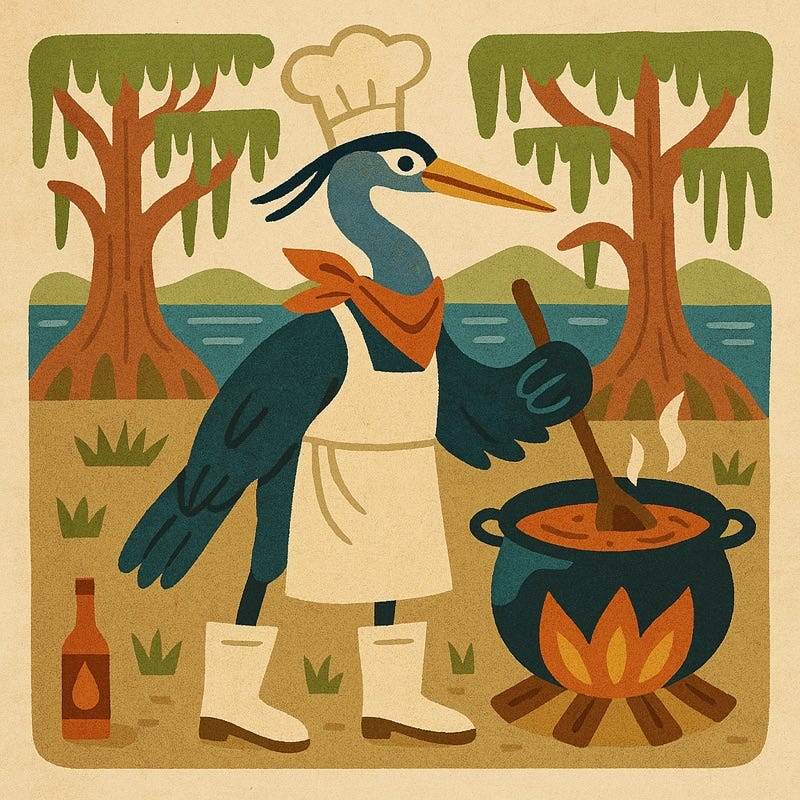Cayenne
The Depth, the Heat, the Hill to Die On
Cayenne pepper is more than just heat. This bold red spice brings depth, balance, and unmistakable flavor to dishes around the world. From Louisiana gumbo to Indian tandoori, cayenne adds a clean, lingering warmth that cooks have relied on for centuries. In this issue, we explore cayenne’s origins, how it shaped regional cuisines, and why it remains a cornerstone in both everyday kitchens and global culinary traditions. Whether you use a pinch or a punch, cayenne is a spice that knows exactly what it is.
If you enjoy learning how ingredients shape the food we love, subscribe to Make a Roux Already for culinary deep dives delivered straight to your inbox.

What Makes Cayenne Different
You know how black pepper hits you sharp and quick? How chili flakes bring those rough edges and bits of texture? How jalapeños give you that fresh, grassy bite? Cayenne does something completely different. It slips into a dish with clean, smooth warmth and just... stays. Doesn’t fight for attention. Just completes what you’re cooking.
The secret is capsaicin, which is cayenne’s almost pure heat compound. It shows up fast, fades evenly, and won’t assault your sinuses. Other peppers bring bitterness or that harsh burn that lingers too long. Cayenne stays focused. No chunks, no seeds. Just fine red powder that disappears into whatever you’re cooking.
This is exactly why it works so well in Louisiana food. Think about it. Cajun and Creole dishes are built on rich foundations. Dark roux, smoked sausage, salted meats. You need heat that plays well with all that richness, not something that’s going to bulldoze over everything else. Cayenne brings just enough brightness to cut through the fat and wake up your taste buds without taking over the whole show.
Most grocery store cayenne runs between 30,000 and 50,000 Scoville units. Hotter than jalapeños, milder than habaneros or Thai chilies. But here’s the thing about cayenne: it doesn’t come with attitude like those flashier peppers. It’s got backbone without the bravado.
So how did this particular pepper end up in the bayous, becoming so essential to Louisiana cooking?
The Journey to Louisiana
Cayenne’s story starts in South America, where Indigenous farmers first cultivated wild Capsicum annuum peppers. The spice gets its name from a city in French Guiana, but its roots go much deeper. Over thousands of years, these farmers carefully developed the slender, fiery varieties we know today, perfect for drying and grinding.
From there, cayenne made its way across the Atlantic. By the early 1700s, it was traveling colonial trade routes that connected South America, West Africa, the Caribbean, and the Gulf Coast. Ships pulling into New Orleans carried more than just cargo. They brought enslaved West Africans who carried their culinary knowledge with them. These skilled cooks blended Old World techniques with new ingredients, creating what became Creole cuisine.
Cayenne pepper found its way into those kitchens as both seasoning and statement. It showed up in stews, sauces, and roux-based dishes, always doing more than just adding heat. By the early 1800s, you could find it in cookbooks and market inventories throughout New Orleans. It had become essential.
You can actually trace its path through written records. American Cookery by Amelia Simmons, the first American cookbook published in 1796, lists cayenne in its recipes. Caribbean and British texts from earlier decades mention it too, often in the hands of enslaved cooks working plantation kitchens. Cayenne didn’t just arrive in America through trade. It came through people. African, Indigenous, Caribbean, and European cooks all worked across cultural boundaries, adapting heat to hearth.
Building Flavor with Cayenne
Knowing cayenne’s history helps explain why it works so well in kitchens today. The key is using it with purpose.
Add it early: Bloom it gently in oil to release subtle aromas while building warmth that spreads through the whole dish.
Add it late: It hits sharper, like a final flourish on your tongue.
In roux-based cooking, cayenne really shines. The fat helps dissolve and distribute capsaicin, making every bite count. That’s why you see it so often in gumbo, sauce piquante, and étouffée. It slips into the base and stays there, steady and balanced.
Unlike chili flakes or coarse blends, cayenne won’t distract with visible bits or unpredictable bursts of heat. It’s precise. When you get the timing right, it can shape a dish’s entire flavor profile without ever announcing itself.
The vibrant red color comes from carotenoids like capsanthin and capsorubin, which fade when the spice gets old or sits under bright lights too long. If your cayenne has turned dull orange, it's probably lost some punch.
Why It Disappeared and Returned
For much of the mid-20th century, cayenne fell out of favor. In postwar America, convenience beat flavor every time. Processed foods and timid palates pushed out anything with stand-out personality. Heat felt too aggressive, too foreign. Cayenne survived in some Southern kitchens, especially in Louisiana, but vanished from most American tables.
Things shifted in the ’70s and ’80s. Natural food movements picked up steam, wellness trends exploded, and cayenne found new life in detox drinks and metabolism boosters. At the same time, Americans started getting curious about global cuisine, rediscovering bold flavors that other cultures had never abandoned.
Now cayenne lives in two worlds. One cook reaches for it because that’s how their grandmother made gumbo. Another stirs it into lemon water for a morning ritual. It bridges old-school cooking and modern health kicks. Whatever brought it back, cayenne has found its footing again. For now, it’s not going anywhere.
Cayenne in Practice
This comeback story explains why cayenne shows up everywhere now, from traditional recipes that never let it go to modern dishes that rediscovered what it could do.
Dishes That Rely on Cayenne
Red beans and rice: Brightens the beans and cuts through all that salt.
Buffalo wings: The classic American heat, usually from cayenne powder or hot sauce built on a cayenne base.
Piri Piri chicken: Cayenne teams up with African bird’s eye chiles for serious layered fire.
Tandoori marinade: That gorgeous red color and steady heat that makes everything better.
Arrabbiata sauce: Italian tomato sauce that gets its kick from cayenne’s sharp bite.
Deviled eggs: Sometimes just a pinch is all you need for a classic.
Storage Tips
Keep cayenne in an airtight container, tucked away from light and heat. If you really want to taste the difference, buy whole dried cayenne peppers and grind them yourself. Yes, it’s an extra step, but the color stays bright and the flavor stays fierce.
Featured Recipe: Chicken and Sausage Gumbo
Serves 6 to 8
This is where cayenne earns its keep. Not just heat, but backbone. It’s the kind of seasoning that holds everything together while letting each flavor shine. The roux, the holy trinity, even the stock all get better with that clean cayenne edge.
I like my roux the color of peanut butter. Dark enough for real flavor, light enough to avoid any bitter notes. Go darker if you want more smoke and depth. Either way, you’re building something worth remembering.
Ingredients
½ cup neutral oil (canola or vegetable)
½ cup all-purpose flour
6 cups chicken stock, warmed (homemade if you’ve got it)
1 bay leaf (optional)
1½ lbs boneless, skinless chicken thighs, cut into bite-sized pieces
1 lb andouille sausage, sliced into ½-inch rounds
1½ cups diced yellow onion
1 cup diced green bell pepper
1 cup diced celery
4 cloves garlic, minced
2 teaspoons Cajun seasoning (taste and adjust)
¼ to ½ teaspoon cayenne
½ teaspoon dried thyme
Salt and black pepper to taste
Hot sauce, to taste
Cooked white rice
Optional: sliced green onions (white parts reserved) or chopped parsley
Instructions
1. Make the peanut butter roux.
In a medium saucepan over medium heat, combine the oil and flour. Stir constantly until the roux reaches the color of peanut butter or a shade darker. This takes about 20 to 30 minutes, so be patient. Keep the heat moderate to prevent burning, and don't be afraid to lower it if the roux starts to smoke. Once it's ready, slowly whisk in the warm chicken stock until smooth. Toss in the bay leaf if you're using one, then let it simmer gently on low heat while you work on the base.
2. Build the flavor base.
Season the chicken lightly with salt and Cajun seasoning. In a large Dutch oven, sear it over medium-high heat until golden. No need to cook it all the way through. Remove and set aside. In the same pot, brown the sausage until it's got some good color on it. Set it aside with the chicken.
Turn the heat down a bit and add the onions, white parts of the green onions, bell pepper, and celery. Sauté until they're soft and translucent, about 5 minutes. Stir as you go to scrape up all those beautiful browned bits from the bottom of the pot. Add the garlic, thyme, Cajun seasoning, and cayenne. Cook just until it smells amazing, maybe 30 to 60 seconds.
3. Combine.
Return the chicken and sausage to the pot and stir everything together. Slowly ladle in the roux-stock mixture, and stir to combine.
4. Simmer.
Bring the gumbo to a gentle boil, then dial it back to a low simmer. Cover it partway and let it bubble away for 45 to 60 minutes, stirring now and then and skimming off any fat that rises to the surface.
5. Taste and finish.
Remove bay leaf. Give it a taste and adjust the salt, black pepper, and seasoning as needed. A dash of hot sauce never hurts if you want more heat. If your gumbo's looking too thick, just thin it out with a little warm water or stock.
6. Serve.
Ladle it over warm rice and top with chopped parsley or green onions. Keep the hot sauce handy because everyone likes their gumbo a little different. And here's the thing: it's even better the next day.
Notes
Roux color: A medium roux gives you that nutty flavor and good body. Go darker if you want more depth, but remember it won't thicken as much. A wide range of roux color will work. It just depends on what you're after.
Sausage: Andouille is the classic choice, but any good smoked sausage with some fat and spice will do the job.
Chicken: Do yourself a favor and use thighs. They've got more flavor and won't dry out on you like breast meat will.
Stock: This dish is only as good as your stock, so don't cheap out here. Use the real deal.
If this piece sparked a memory, taught you something new, or made you hungry for gumbo, I’d love to hear from you. Drop a comment below and let me know how cayenne shows up in your kitchen. And if you know someone who’d enjoy this deep dive into flavor, share it with them. Every share helps keep the pot stirring.
If music moves you and meaning matters, subscribe to Drop the Needle: Music That Matters. Twice a month, you’ll get curated playlists and thoughtful commentary that go beyond the notes. Hear the music. Feel the story. Join us.


